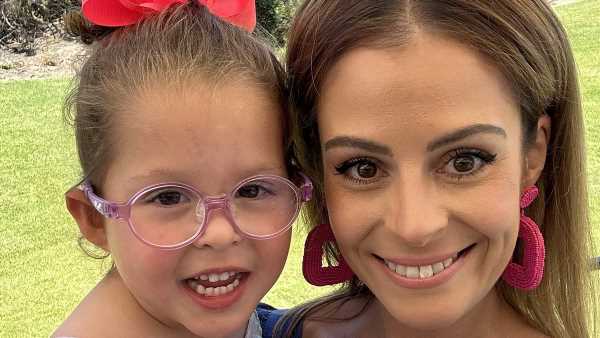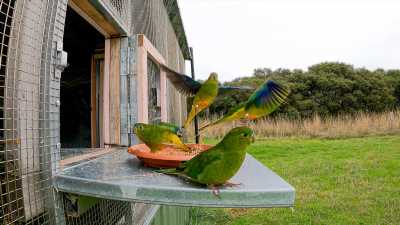Blooming cute! Girl, 3, with cerebral palsy who’s shy about walking in public because people stare beats her nerves as an adorable flower girl at her aunt’s wedding
- Ruby Cochrane, 3, from Australia, finds it difficult for her to walk without an aid
- READ MORE: Type of fat in breast milk might hold cure to cerebral palsy
A toddler with cerebral palsy bloomed into the perfect flower girl during her aunt’s wedding.
Ruby Cochrane, three, from Melbourne, was born to mum Stephanie Cochrane, 37, ten weeks premature, before being diagnosed with the debilitating condition – which makes it difficult for her to walk without an aid.
Cerebral palsy is a lifelong condition that occurs when a baby’s brain is starved of oxygen during or shortly after birth.
In most cases, this is due to a difficult labour, but it can occur as a result of an infection of the brain or head injury.
Stephanie, a stay-at-home mother-of-three, says ‘people stare’ at Ruby, and as a result, the tot has grown increasingly insecure about walking in public.
Ruby Cochrane, three, bloomed into the perfect flower girl during her aunt’s wedding, despite being diagnosed with cerebral palsy – a condition which makes it difficult for her to walk without an aid (Pictured: Ruby walks down the aisle with her brothers Jack and Josh, both five)
Ruby Cochrane was born to mum Stephanie Cochrane, 37, (pictured) ten weeks premature, before being diagnosed with the debilitating condition. Stephanie says ‘people stare’ at Ruby, and as a result, the tot has grown increasingly insecure about walking in public
Still, the little hero conquered her fears by attempting to walk down the aisle as a flower girl, with nothing but her walker to help.
Stephanie revealed: ‘She was very nervous about it because when we’re in public we get stares. She doesn’t like being looked at like that.
‘She was worried that she wouldn’t make it to the end but they did it. Her brothers really helped her do it.
‘In the end she loved it. She actually enjoyed the people looking at her this time’.
Ruby’s aunt and uncle, whose names are withheld, wanted Ruby to be the flower girl, while her two brothers Jack and Josh, both five, were to be the page boys.
As her brothers supported the walker, Ruby held on tight and eventually made it down the aisle to smooth success.
Her family were chuffed, particularly Ruby’s aunt and uncle, who are ‘very close with Ruby’ and have no kids have their own.
Although the youngster was initially anxious about walking down the aisle, her boldness in the face of adversity as done wonders for her self confidence.
The little hero conquered her fears by attempting to walk down the aisle as a flower girl, with nothing but her walker to help
Her brothers were in tow to support Ruby as she held on to the walker and eventually made it down the aisle to smooth success
WHAT IS CEREBRAL PALSY?
Cerebral palsy is the name for a set of conditions affecting movement and co-ordination stemming from a problem with the brain that takes place before, during or soon after birth.
Symptoms are not typically obvious immediately after a child is born — but instead normally become noticeable after two or three years.
They include delays in reaching development milestones, such as:
- not sitting by eight months;
- not walking by 18 months;
- appearing too stiff or too floppy;
- walking on tip-toes;
- weak arms or legs;
- fidgety, jerky or clumsy movements;
- random, uncontrolled movements;
Difficulty speaking, swallowing or seeing — along with learning difficulties — can also be symptoms.
Cerebral palsy symptoms can be caused by a number of things and are not necessarily an indication of the condition, which can occur if a child’s brain does not develop normally while in the womb, or is damaged during or soon after birth.
Causes include bleeding in the baby’s brain, reduced blood and oxygen supply, infection caught by the mother while pregnant, asphyxiation during a difficult birth, meningitis or a serious head injury – though the precise cause is often not clear.
There is no cure currently, but physiotherapy, speech therapy, occupational therapy and medication are often used as treatment.
Each person living with the condition is affected in a different way, but generally speaking most children live into adult life and some can live for many decades.
‘This has really boosted her confidence walking, she held her head a little higher after that’ adds Stephanie.
Last year, a damning report revealed that errors during childbirth were to blame for hundreds of children born with cerebral palsy over the past decade.
An analysis of more than 1,000 NHS negligence claims shows that serious mistakes include delayed delivery, maternity staff missing the signs of foetal distress and failing to respond to the umbilical cord being wrapped around a baby’s neck.
The study, by law firm Lime Solicitors, reckons that errors leading to cerebral palsy-related claims costs the NHS an average of £493million every year in compensation and legal fees.
Robert Rose, head of clinical negligence at Lime Solicitors, said: ‘Regrettably, I have seen many of these mistakes before. We know the lessons that should have been learned, but unfortunately, time and time again, the same faults are made.’
In 2020-2021, 281 cases of preventable cerebral palsy were reported – the highest number since 2010 and a fifth of the ten-year total.
Source: Read Full Article






